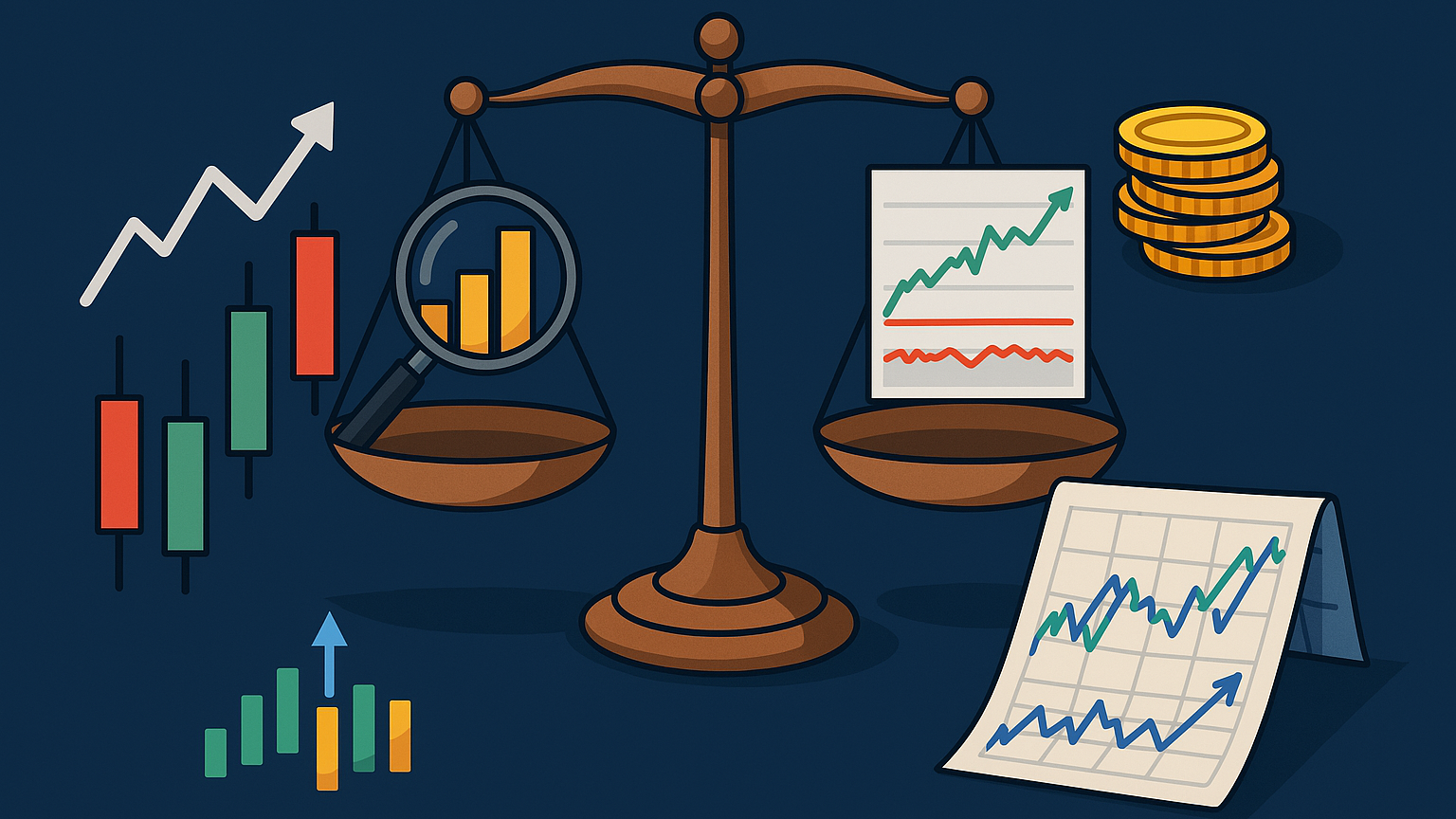Learn how to effectively blend short-term trading with long-term investing for balanced growth and reduced risk in your portfolio.
- What It Is: A mix of trading styles using both technical and fundamental analysis.
- Why It Works: Reduces risk, adapts to market changes, and offers both steady growth and quick gains.
- Who It's For: Intermediate to advanced traders who can manage multiple positions and analyze markets effectively.
- How to Start
- Set clear goals (e.g., 2-3% monthly trading return, 8-10% annual long-term growth).
- Allocate capital wisely (e.g., 20-30% for active trades, 50-60% for core investments).
- Use tools like moving averages, RSI, and stop-loss orders to manage trades.
Quick Tip:
Use profits from short-term trades to strengthen your long-term investments. This strategy can help you grow your portfolio while keeping risks under control.
Swing Trade combining Fundamental & Technical analysis for optimum returns
Creating Your Hybrid Strategy

Plan your hybrid trading strategy to balance short-term gains with long-term growth. This requires clear goals, defined risk limits, and a thoughtful approach to market selection.
Setting Goals and Risk Limits
Define specific trading goals that align with your risk tolerance. Here's a quick breakdown:
| Time Horizon | Goal Type | Example Target |
|---|---|---|
| Short-term | Active Trading | 2-3% monthly return on trading capital |
| Medium-term | Mixed Approach | 15-20% annual portfolio growth |
| Long-term | Investment | 8-10% compound annual growth rate |
"Setting realistic trading goals is essential for traders as it provides a clear roadmap for growth in trading and mitigates unnecessary risks." - Ben Clay, Freelance Content Writer and Strategist
When setting risk limits, think about how much market volatility you can handle emotionally. As Charlie Horonzy, Certified Financial Planner, puts it: "Everyone's risk tolerance is going to be different".
Once your goals and risk limits are clear, allocate your trading capital accordingly.
Dividing Trading Capital
A hybrid strategy works best when you balance active trading with stable core investments. For example, while stocks have historically delivered strong returns, they also experience losses roughly one-third of the time.
Here’s a suggested allocation framework:
| Strategy Component | Allocation Range | Risk Profile |
|---|---|---|
| Active Trading | 20-30% | Higher Risk/Return |
| Core Investments | 50-60% | Moderate Risk |
| Cash Reserve | 10-20% | Safety Buffer |
Regularly rebalance your portfolio to keep your asset mix aligned with your strategy and to take advantage of changing market conditions.
Selecting Markets to Trade
After allocating your capital, focus on choosing the right markets for your hybrid strategy. For long-term positions, the S&P 500 index fund offers a historical average annual return of 11.34% (1950-2023). Keep in mind that only about 10% of day traders are consistently profitable.
To choose markets effectively, consider:
- Liquidity: High trading volume is essential for active trading.
- Volatility: Match market risk with your comfort level.
- Tax Implications: Long-term gains are taxed at 0-20%, while short-term gains can reach 20-35%.
- Market Hours: Align market schedules with your availability.
- Correlation: Pick markets that provide true diversification.
Keep your long-term investments and short-term trades separate to minimize unnecessary losses.
Short-Term Trading Methods
Short-term trading demands accurate technical analysis and disciplined execution.
Finding Trading Setups
Spotting high-probability trading setups involves analyzing technical patterns and market trends. Different setups come with distinct success rates and holding periods:
| Setup Type | Win Rate | Hold Time | Risk-Reward |
|---|---|---|---|
| Breakout | 45-55% | 2-5 days | 1:2 |
| Support/Resistance | 50-60% | 1-3 days | 1:1.5 |
| Moving Average Crossover | 40-50% | 3-7 days | 1:2.5 |
To confirm a setup:
- Check trading volume to validate breakouts or reversals.
- Use multiple timeframes to verify support and resistance levels.
- Combine price action with the overall market environment.
- Stick to one or two specific setups to build expertise.
Once you've identified setups, technical indicators can refine your entry and exit points.
Key Technical Indicators
Here are some essential technical indicators to guide your trades:
- Moving Averages (MA): Start with the 20-day simple moving average (SMA) for short-term trends and the 200-day SMA for long-term trends. Bullish momentum may be indicated when a shorter MA crosses above a longer one.
-
Relative Strength Index (RSI): This helps spot overbought or oversold conditions:
- Below 30 = oversold (potential buy signal).
- Above 70 = overbought (potential sell signal).
- Bollinger Bands: These are set two standard deviations from the 20-day SMA. They can highlight potential reversals, especially when paired with RSI signals.
These indicators help you time your trades and manage risk more effectively.
Managing Short-Term Risk
Risk management is absolutely critical for short-term trading. Here’s how to protect your capital:
- Position Sizing: Limit your risk to 1-2% of your total capital per trade. For a $10,000 account, this means risking $100–$200 per trade.
-
Stop-Loss Placement: Use these methods to safeguard your trades:
- For breakout trades, set stops 10-15% below the breakout level.
- For reversal trades, place stops 1-2 ATR (Average True Range) away from your entry point.
- Use support and resistance levels as natural stop-loss markers.
Did you know? A 95% loss requires a 1900% gain just to break even.
To keep emotions in check, establish clear rules for:
- Maximum daily loss limits.
- The number of trades you hold at once.
- When to scale in or out of positions.
- Profit-taking targets.
Integrate these strategies into your overall trading approach to stay disciplined and protect your portfolio.
Long-Term Investment Methods
Balance your active trading with a disciplined, long-term investment strategy. This requires careful analysis and a structured approach to execution.
Company Analysis Basics
Long-term investments are often guided by fundamental analysis, which evaluates companies through both qualitative and quantitative lenses.
Qualitative factors include aspects like the sustainability of the business model, competitive advantages, management expertise, and industry growth trends.
"A company's long-term success is primarily driven by its ability to maintain its competitive advantage." – Investopedia
On the quantitative side, focus on key financial ratios to assess a company’s performance:
| Category | Key Ratios |
|---|---|
| Profitability | ROE, Net Margin |
| Liquidity | Current Ratio |
| Solvency | Debt-to-Equity Ratio |
| Valuation | P/E Ratio (compared to industry) |
Use these insights to create a structured plan for gradually building your investment positions.
Regular Investment Planning
Adopt systematic strategies like dollar-cost averaging to reduce risk and take advantage of the S&P 500’s historical 10% annual return rate.
A solid position-building strategy might include:
- Allocating fixed amounts at regular intervals
- Using dollar-cost averaging to smooth out market fluctuations
- Adding to positions during market downturns
- Keeping cash reserves ready for new opportunities
"Over the last seven decades, volatility has led some investors to think of investing as being unsafe. However, as time increases, portfolio volatility decreases." – Jack Manley, Global Market Strategist
Portfolio Management
After building your positions, active portfolio management ensures your investments remain aligned with your financial goals.
- Monthly: Check position weights to maintain balance.
- Quarterly: Reassess company fundamentals.
- Annually: Review your overall strategy for alignment.
Diversification is key to managing risk. A mix of growth-focused assets, conservative holdings, and uncorrelated investments has historically delivered around 8% annual returns over the past 15 years. Keep your portfolio balanced to weather market fluctuations while pursuing steady growth.
Combining Trading Approaches
To make the most of your hybrid strategy, blend active trading techniques with long-term investments. This way, you can aim for higher profits while keeping risks under control.
Short-Term Profit Tactics
Use multi-timeframe analysis to fine-tune your trades. Each timeframe has a specific purpose:
| Timeframe | Purpose | How to Use |
|---|---|---|
| Daily Charts | Identify the main trend | Set overall strategy |
| 4-Hour Charts | Pinpoint intermediate trends | Spot trade setups |
| 1-Hour Charts | Track short-term signals | Perfect entry and exit timing |
Take advantage of seasonal trends. For example, most S&P 500 gains happen between November and April. Adjust your trading pace and position size during these periods for better results.
Using Long-Term Assets
Put profits from your active trades into long-term investments. This builds a stronger portfolio over time.
Risk Distribution
Managing risk is key to staying in the game. Here's how to spread it effectively:
-
Position Sizing
Limit active trade risk to 2% of your capital. Remember, a 10% loss requires an 11.1% gain just to recover. -
Stop-Loss Strategies
Use automated stop-loss orders for active trades. For long-term investments, rely on flexible exits based on fundamental analysis. -
Portfolio Balance
Combine active trades with stable, long-term holdings. This approach helps reduce risk, especially since 65% of retail investors lose money trading CFDs.
As Ed Seykota famously said, "Cut your losses". Following disciplined risk management ensures smarter decisions and minimizes unnecessary exposure.
Trading Software and Tools
Pick solutions that work well for both active trading and long-term investment strategies.
Trading Platform Selection
When selecting a trading platform for a hybrid approach, look for one that offers flexibility and a wide range of features. Here's a comparison of three popular platforms:
| Platform | Active Trading Features | Long-Term Investment Tools | Best For |
|---|---|---|---|
| Interactive Brokers | Advanced analytics, global market access (150+ countries) | Portfolio analysis, retirement planning | Experienced traders needing global access |
| Fidelity | Real-time data, advanced charting | ETF research, educational content | Well-rounded hybrid traders |
| E*TRADE | Advanced charting, mobile trading | Portfolio management, risk assessment | Tech-savvy traders seeking mobility |
Look for platforms that offer multi-asset support, real-time data, and strong security features. These solutions form the backbone of any successful trading strategy.
LuxAlgo Trading Indicators
LuxAlgo offers a suite of exclusive trading indicators on TradingView tailored for hybrid traders. A standout feature is the Reversal Signals indicator, which identifies potential trend changes by analyzing momentum phases and detecting when trends may be losing steam. For example, Portfolio Boss users have reported annual gains of 31% and 80% using specific strategies.
These solutions go beyond basic analysis, helping traders make more informed decisions.
AI Trading Tools
Artificial intelligence is transforming trading by automating processes and delivering sharper insights. LuxAlgo's AI Backtesting Assistant offers several advantages:
- Automated discovery of strategies across various timeframes
- Access to thousands of strategies through the Signals & Overlays (S&O) and Price Action Concepts (PAC) toolkits
- Real-time strategy evaluation and improvement
"Trading as a business... having the correct tools makes all the difference", says Richard Coombe, a Portfolio Boss Founders Club Member.
"I had the confidence to predict what my returns were going to be... this lets the everyday trader compete with the big boys".
It's worth noting that algorithmic trading now makes up more than 50% of US equity market turnover. Incorporating AI tools into your workflow can help you seamlessly combine active trading with long-term investment goals.
Conclusion
Main Points
Hybrid trading combines the fast-paced nature of active trading with the steadiness of long-term investing. This blend relies on market analysis and disciplined risk management to aim for returns across varying timeframes.
"To develop the kind of trading strategy that will add value to your portfolio and lead to solid returns, you'll need to frequently reassess your strategy and adapt it based on your individual risk tolerance, market conditions, and your financial needs." - Investopedia
Getting Started
If you’re ready to dive into hybrid trading, here’s how to get started:
-
Set Your Capital Structure
Be mindful of tax implications: short-term gains are taxed at 20-35%, while long-term gains range from 0% to 20%. Allocate your funds between long-term investments and active trades based on these factors. -
Choose Your Solutions
Opt for platforms that cater to both trading styles. Brokers like Interactive Brokers offer features tailored for active traders and long-term investors alike. -
Implement Risk Controls
- Align position sizes with your risk tolerance.
- Use stop-loss orders to protect active trades.
- Regularly rebalance your long-term portfolio to stay on track.
For added precision, consider solutions like LuxAlgo's AI Backtesting Assistant to fine-tune your hybrid approach while keeping risk in check.







